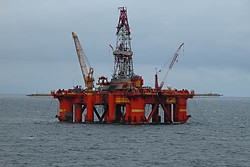[
{
"name": "Top Stories Video Pair",
"insertPoint": "7",
"component": "17087298",
"parentWrapperClass": "fdn-ads-inline-content-block",
"requiredCountToDisplay": "1"
}
]
Begin at the line where land meets ocean and swim or boat three geographical miles out: There, the Outer Continental Shelf begins, extending roughly 200 nautical miles to comprise a 1.7 billion-acre chunk of Atlantic and Pacific ocean-submerged lands governed by the United States Department of the Interior. Out there where the mighty winds blow, great pools of oil lurk.
Some of that oil's been tapped. But much more hasn't and, as everyone knows, lotsa folks have wanted to develop that oil, pump it out and deliver it unto our Fords, Chevrolets and Toyotas, et al. Lotsa other folks, disturbed by oil spills and related troubles, haven't wanted that, and since 1981 the feds have banned oil and gas drilling on the OCS.
Last year, however, President George W. Bush lifted the moratorium and presented a five-year plan to fire up some rigs and get ’er done. But he's out, and in February President Barack Obama's Interior Secretary, Ken Salazar, delayed lifting the ban and extended the public comment period until Sept. 21 in order to give the administration and the public time to develop a more comprehensive plan for energy development on the OCS, including giving more serious study to renewable resource options, in particular harnessing those mighty offshore winds.
Since then, the Interior's Minerals Management Service and U.S. Geological Survey has prepared a report on the OCS's renewable resources and ecologically sensitive areas, and Salazar's team has been presenting the findings at regional hearings this month -- first in New Jersey, then in Louisiana, then Alaska. A fourth and final meeting is this Thursday, April 16, in San Francisco at the University of California-San Francisco's Mission Bay Conference Center.
Said Salazar in a news release last month: "The purpose of these meetings is to have an open, honest conversation with the American people to solicit the best information possible about an offshore energy plan. The Department's efforts over the next six months to develop a comprehensive offshore energy plan will embrace the President's commitment to a government that is open and inclusive and that makes decisions based on sound science and the public interest."
Word is that thousands of activists may descend on the locale to make their worries known about potential impacts to ocean life from drilling and even renewable energy development.
The North Coast harbors conventional and renewable potential: ample waves, strong offshore winds and about 1.6 billion barrels of undeveloped oil, the fifth largest deposit in the U.S. But the Interior's report finds that the greatest renewable energy potential lies on the Atlantic OCS, especially in offshore wind power.
"Strong wind resources also exist offshore California, Oregon, Washington and Hawaii, but it appears that the majority of this resource lies in deep waters where technology constraints are potentially significant," says the executive summary to the report.
As for wave power, says the report, while the potential is high the technology is still too much in its infancy. Also, states may preside over the development of that resource.
Indeed, here in the Humboldt-Mendocino area, within state-governed waters (up to three miles off shore), Pacific Gas & Electric is pursuing an exploratory project called WaveConnect. It would set up two platforms, one in Mendocino and one in Humboldt, upon which a number of manufacturers could demonstrate their wave energy conversion devices. PG&E spokesman David Eisenhauer said Tuesday that the utility plans to file a draft license application for a small pilot project by spring 2010, following studies and public hearings. PG&E secured $4.8 million for the project in January from the California Public Utilities Commission, and will get another $1.2 million from the Department of Energy.
The PUC wasn't so keen on another wave project that PG&E was involved in. Last October, it rejected a power purchase agreement between PG&E and British Columbia-based company Finavera to develop what would have been the U.S.'s first-ever wave energy project 2.5 miles off the coast of Eureka. The PUC said the technology was too new, and the project unviable. In February, Finavera gave up its preliminary permit with FERC for the project. The company has no further plans to pursue wave energy in this area, said a spokesman on Tuesday.
more from the author
-
From the Journal Archives: When the Waters Rose in 1964
- Dec 26, 2019
-
Bigfoot Gets Real
- Feb 20, 2015
-
Danger at McCann
A kayaker's death has raised safety questions about low-water bridges
- Feb 19, 2015
- More »
































